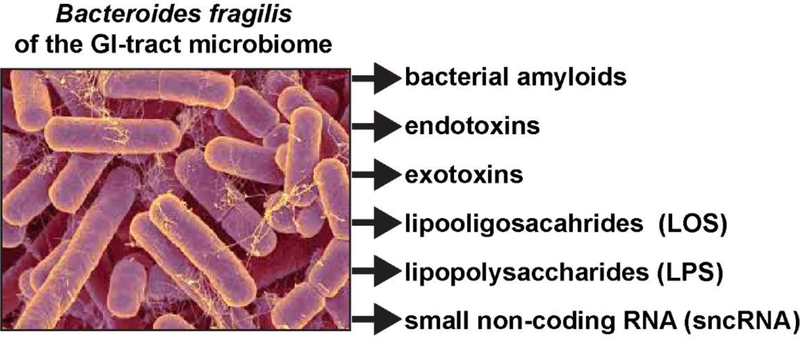FIGURE 2 -.
Comparable to all other anaerobic Gram-negative bacilli, the gastrointestinal (GI) tract abundant Bacteroides fragilis is capable, when stressed, of releasing a broad spectrum of highly neurotoxic, pro-inflammatory and potentially pathogenic molecules; these comprise six major classes of secreted molecules and include bacterial amyloids, endotoxins, exotoxins, lipooligosacahride (LOS; consisting of smaller isoforms of LPS), lipopolysaccharide (LPS; in this photo yellowish filamentous structures associated with some B. fragilis bacillus rods) and small non-coding RNAs (sncRNA; some similar in size to microRNAs). For example, the human GI tract-abundant B. fragilis secretes the endotoxin-LPS B. fragilis LPS (BF-LPS) which has been shown to be strongly pro-inflammatory and extremely neurotoxic toward human CNS neurons in primary culture; BF-LPS may be the most pro-inflammatory bacterial-derived glycolipid known [5,6,26,51–53]. While the phyla Bacteriodetes (representing about ~24% of all GI-tract bacteria), Firmicutes (~72% of all GI-tract bacteria), Actinobacteria, Proteobacteria, and Verrumicrobia (together, typically ~4% of all GI-tract bacteria), are the most common microbes in the human GI tract microbiome it should be kept in mind that other microbes including fungi, protozoa, viruses, and other commensal microorganisms may also contribute neurotoxic exudates which are highly toxic, pro-inflammatory and detrimental to the homeostasis of CNS neurons; (micrograph of B. fragilis shown; the original photo is shown courtesy of Rosa Rubicondior; http://rosarubicondior.blogspot.com/2014/11/evolving-cooperation-but-for-who-or-what.html; last accessed 7 October 2019).

